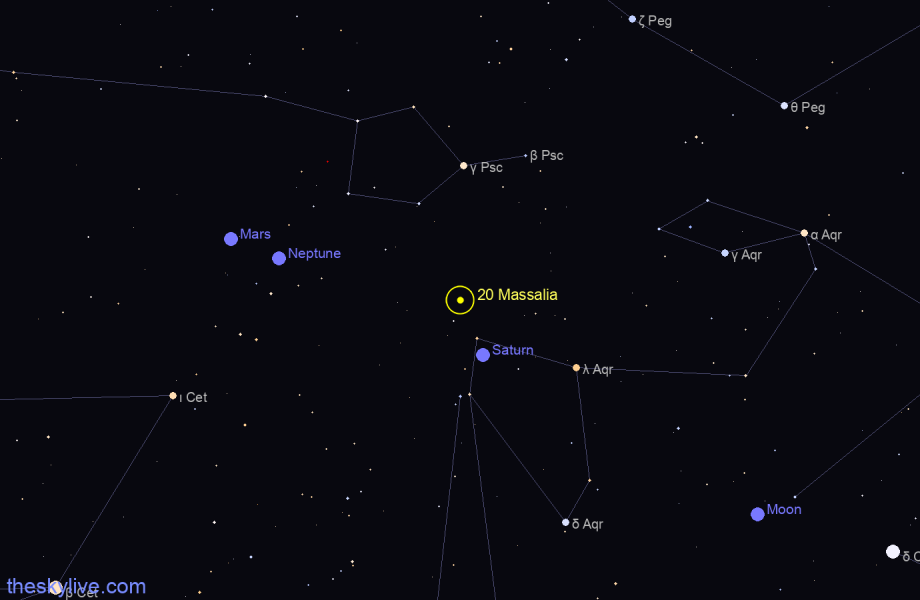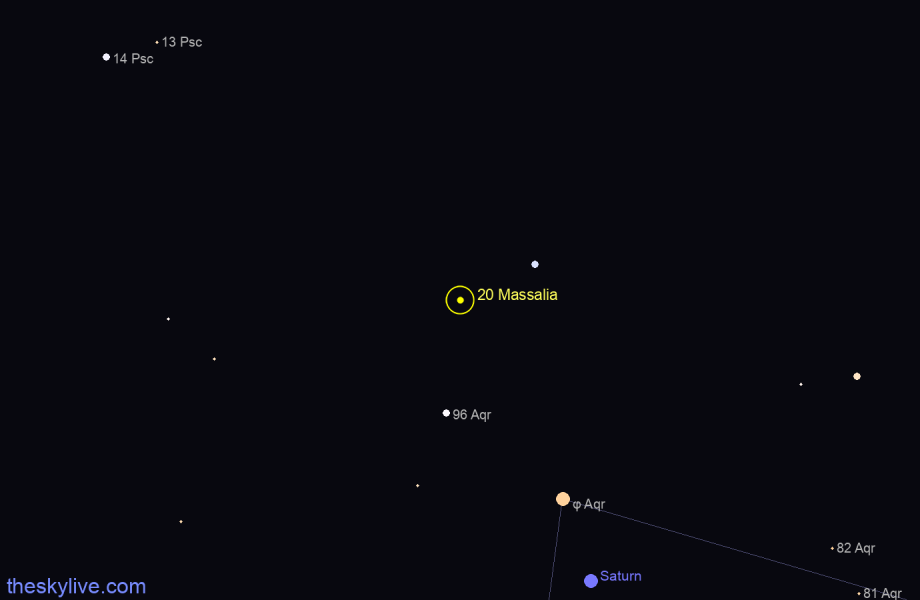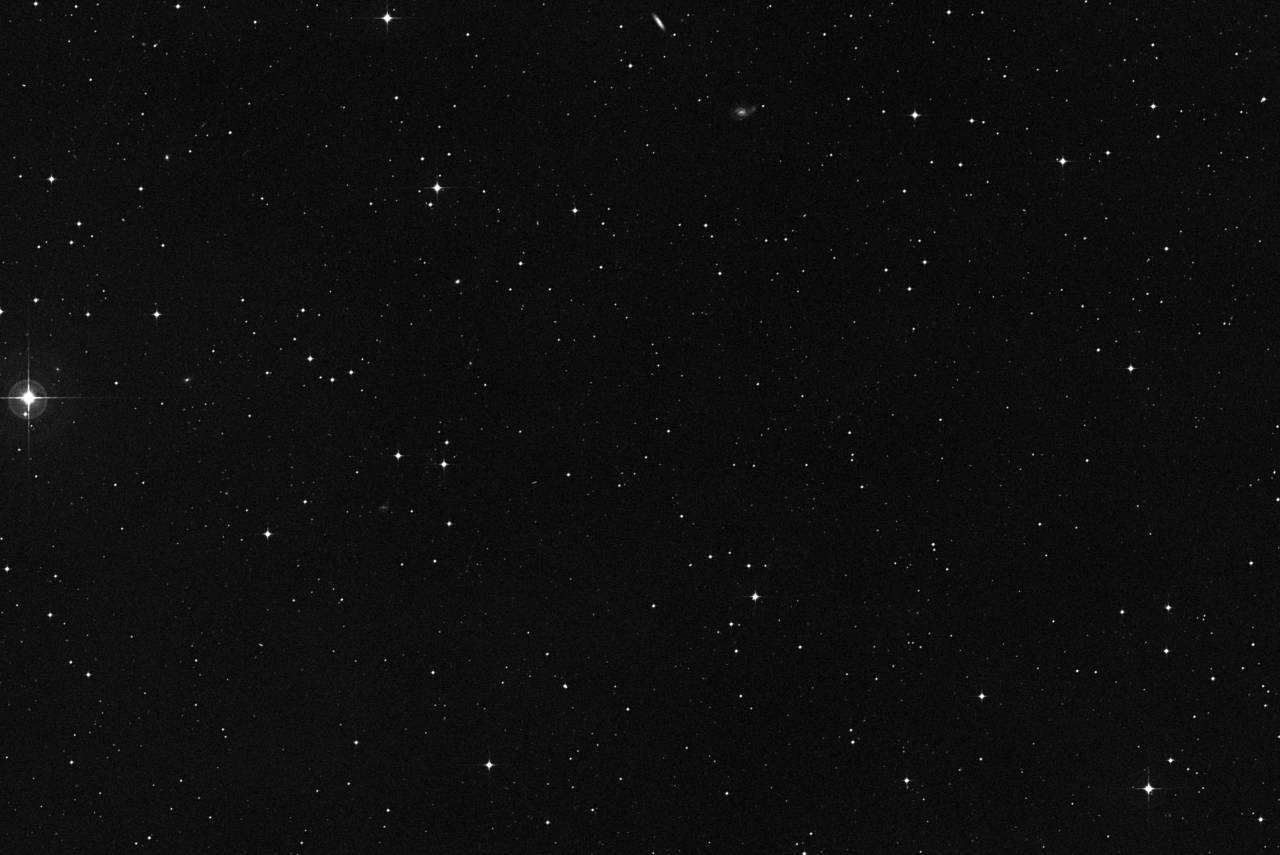Asteroid 20 Massalia
Asteroid 20 Massalia was discovered by astronomer Annibale de Gasparis on September 19, 1852. It is named after the ancient Greek city of Massalia, which is now modern-day Marseille, France. Massalia is a relatively large and bright asteroid, with a diameter of about 146 kilometers. It is classified as an S-type asteroid, meaning that it is composed primarily of silicate rock and metal. Massalia has a relatively short rotation period of just over 6 hours and orbits the Sun every 4.3 years at an average distance of 2.41 astronomical units (AU).
Asteroid 20 Massalia is currently in the constellation of Aquarius, at a distance of 481,630,093 kilometers from Earth.
View interactive star map
Today's rise, transit and set times of Asteroid 20 Massalia from Greenwich, United Kingdom (all times relative to the local timezone Europe/London):
- 20 Massalia is below the horizon from Greenwich, United Kingdom .
- Given its current magnitude, 20 Massalia is visible with the help of a telescope having an aperture of 4 inches (100mm) or more.
- Go to interactive sky chart
If you need to access this information frequently for your observations, you can create a simple customized Quick Access page, so that you can easily bookmark it in your browser favorites or add a shortcut to your mobile phones' home screen.
Asteroid 20 Massalia Position and Finder Charts
Field of view: 10x6 degrees
View fullscreen
Higher precision deep sky finder chart, 60 arcmin wide, showing where Asteroid 20 Massalia is right now. Click on the image to see a more detailed fullscreen tracker view.
Also check out Where is Asteroid 20 Massalia?, a page that provides all the information needed to find Asteroid 20 Massalia in the sky and additional links to sky charts.
Asteroid 20 Massalia Distance from Earth
The distance of Asteroid 20 Massalia from Earth is currently 481,630,093 kilometers, equivalent to 3.219498 Astronomical Units. Light takes 26 minutes and 46.5451 seconds to travel from Asteroid 20 Massalia and arrive to us.
The following chart shows the distance of Asteroid 20 Massalia from Earth as a function of time. In the chart the distance data is measured in Astronomical Units and sampled with an interval of 1 day.
The value of the reported distance might be somewhat inaccurate around the times of closest approach for objects passing extremely close to Earth. The value of the distance of 20 Massalia from Earth is also available as a real time updated value in the Live Position and Data Tracker.
Closest Approach of Asteroid 20 Massalia to Earth
Between 1 January 1900 and 31 December 2099, the closest approach of Asteroid 20 Massalia to Earth happens on Mon Jan 6 2048 at a distance of 1.077062 Astronomical Units, or 161,126,212 kilometers:
NOTE: values for the closest approach are computed with a sampling interval of 1 day.
Asteroid 20 Massalia Brightness and Light Curve
The following chart is the predicted light curve (visual magnitude as a function of time) of Asteroid 20 Massalia, according to the most recent ephemerides data. Magnitude data is sampled with a 2 days interval and there might be inaccuracies for objects changing brightness very rapidly during the course of a few days. For comets there could be large discrepancies between the observed and predicted brightness because of their highly dynamic behaviour.
Asteroid 20 Massalia Orbital Elements
The following table lists the orbital elements of Asteroid 20 Massalia at epoch 24 February 2023 00:00 UTC (JD: 2460000.5). Source: JPL Small-Body Database
| Element | Symbol | Value |
|---|---|---|
| Orbit eccentricity | e | 0.14328810 |
| Orbit inclination | i | 0.70919118° |
| Perihelion distance | q | 2.06345443 AU 308,688,390 km |
| Aphelion distance | Q |
2.75369454 AU 411,946,840 km |
| Semi-major axis | a |
2.40857448 AU 360,317,615 km |
| Orbital period | period |
3.7381 years 1,365.3329 days |
| Date of perihelion transit | Tp | 2021-Nov-04 02:43:02 2,459,522.6132 JD |
| Next perihelion transit | 2025-Jul-31 10:42 2,460,887.9461 JD |
|
| Argument of perihelion | peri | 257.50682680841° |
| Longitude of the ascending node | node | 205.9677482734° |
| Mean anomaly | M | 126.00534306121° |
| Mean motion | n | 0.26367196°/day |
Visualization of Asteroid 20 Massalia Orbit
This 3d orbit diagram is a feature of our 3D Solar System Simulator and shows the orbit of Asteroid 20 Massalia with respect of the Sun and the orbits of the major planets. The position of Asteroid 20 Massalia and the planets along their orbits in this diagram accurately represents the current configuration of the objects in the Solar System. This is an experimental feature and it requires a WebGL enabled browser. Please provide us feedback!
View Asteroid 20 Massalia in the 3D Solar System Simulator
Asteroid 20 Massalia Physical Data
The following shows the known values of the most important physical parameters of Asteroid 20 Massalia. Source: JPL Small-Body Database
| Physical Parameter | Value | Relative to Earth |
|---|---|---|
| Diameter | 145.5 km | 0.0114 |
| Sideral Rotation | 8.0980 hours | 0.3383 |
| Absolute Magnitude | 6.5 | |
| Geometric Albedo | 0.2096 |
Asteroid 20 Massalia 15 Days Ephemeris
The following table lists the ephemerides of Asteroid 20 Massalia computed for the past and next 7 days, with a 24 hours interval. Click on each row of the table to locate Asteroid 20 Massalia in our Online Planetarium at the chosen date.
| Date | Right AscensionR.A. | DeclinationDec. | MagnitudeMag | Constellation |
|---|---|---|---|---|
| 2024 Apr 13 | 22h 49m 23s | -06° 57’ 33” | 12.03 | Aquarius |
| 2024 Apr 14 | 22h 50m 53s | -06° 48’ 29” | 12.03 | Aquarius |
| 2024 Apr 15 | 22h 52m 20s | -06° 39’ 24” | 12.02 | Aquarius |
| 2024 Apr 16 | 22h 53m 49s | -06° 30’ 21” | 12.02 | Aquarius |
| 2024 Apr 17 | 22h 55m 18s | -06° 21’ 19” | 12.02 | Aquarius |
| 2024 Apr 18 | 22h 56m 45s | -06° 12’ 15” | 12.02 | Aquarius |
| 2024 Apr 19 | 22h 58m 13s | -06° 03’ 12” | 12.01 | Aquarius |
| 2024 Apr 20 | 22h 59m 40s | -05° 54’ 11” | 12.01 | Aquarius |
| 2024 Apr 21 | 23h 01m 08s | -05° 45’ 09” | 12.01 | Aquarius |
| 2024 Apr 22 | 23h 02m 34s | -05° 36’ 07” | 12.01 | Aquarius |
| 2024 Apr 23 | 23h 04m 00s | -05° 27’ 06” | 12.00 | Aquarius |
| 2024 Apr 24 | 23h 05m 26s | -05° 18’ 06” | 12.00 | Aquarius |
| 2024 Apr 25 | 23h 06m 52s | -05° 09’ 07” | 12.00 | Aquarius |
| 2024 Apr 26 | 23h 08m 18s | -05° 00’ 09” | 11.99 | Aquarius |





